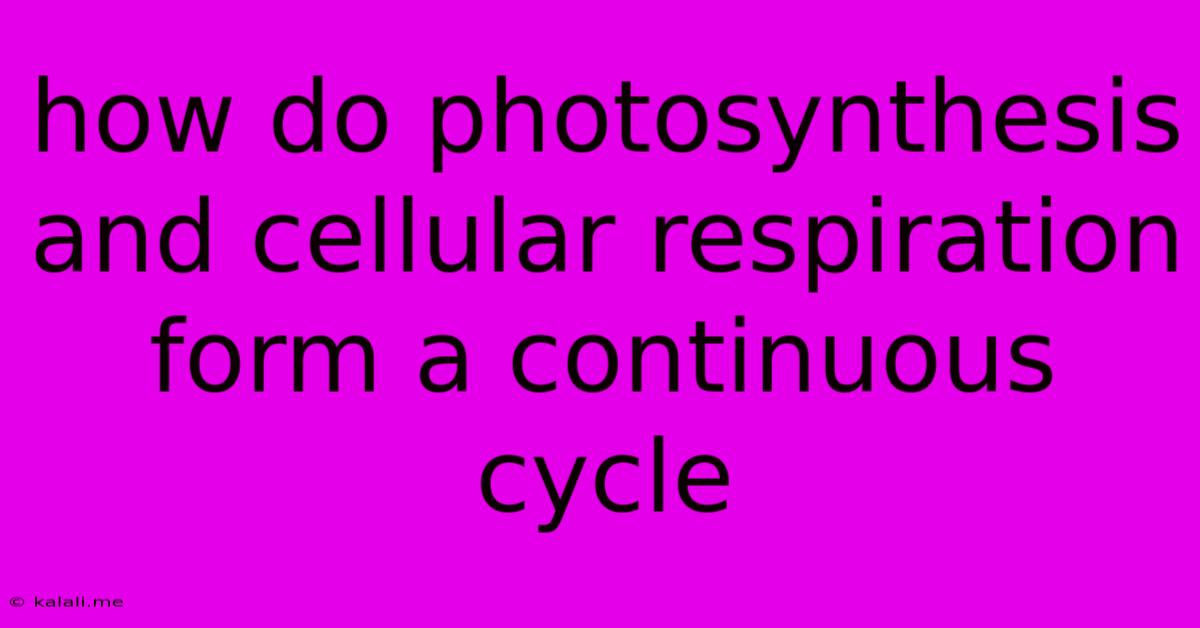How Do Photosynthesis And Cellular Respiration Form A Continuous Cycle
Kalali
May 10, 2025 · 3 min read

Table of Contents
Photosynthesis and Cellular Respiration: A Continuous Cycle of Life
Photosynthesis and cellular respiration are two fundamental processes in biology that are intricately linked, forming a continuous cycle vital for life on Earth. Understanding how these processes work together is key to grasping the flow of energy and matter within ecosystems. This article will explore the interconnectedness of these processes, highlighting their individual roles and how they create a cyclical exchange of energy and essential molecules.
Photosynthesis, the process by which green plants and some other organisms use sunlight to synthesize foods from carbon dioxide and water, is the foundation of most food chains. Cellular respiration, conversely, is the process by which organisms break down glucose to release energy for cellular functions. These seemingly distinct processes are, in reality, two sides of the same coin, working in tandem to maintain the balance of life.
Photosynthesis: Capturing Solar Energy
Photosynthesis takes place primarily in the chloroplasts of plant cells. The process can be summarized as follows:
- Light-dependent reactions: Sunlight's energy is absorbed by chlorophyll and other pigments, converting light energy into chemical energy in the form of ATP (adenosine triphosphate) and NADPH (nicotinamide adenine dinucleotide phosphate). Water molecules are split (photolysis), releasing oxygen as a byproduct.
- Light-independent reactions (Calvin Cycle): The ATP and NADPH produced in the light-dependent reactions power the synthesis of glucose from carbon dioxide. This glucose serves as the primary energy source and building block for the plant.
Essentially, photosynthesis converts light energy into chemical energy stored in glucose, releasing oxygen as a waste product. This oxygen is crucial for aerobic respiration in other organisms.
Cellular Respiration: Releasing Energy from Glucose
Cellular respiration, occurring in the mitochondria of both plant and animal cells, is the reverse process of photosynthesis, in a way. It involves the breakdown of glucose to release the stored chemical energy. The process is broadly divided into several stages:
- Glycolysis: Glucose is broken down into pyruvate in the cytoplasm. This stage produces a small amount of ATP.
- Krebs Cycle (Citric Acid Cycle): Pyruvate is further oxidized, releasing carbon dioxide and generating more ATP and electron carriers (NADH and FADH2).
- Electron Transport Chain: Electrons from NADH and FADH2 are passed along a chain of protein complexes, releasing energy used to pump protons across a membrane. This creates a proton gradient, which drives ATP synthesis through chemiosmosis. Oxygen acts as the final electron acceptor, forming water.
Cellular respiration releases the chemical energy stored in glucose, making it available for cellular work, such as growth, repair, and movement. It produces ATP, the primary energy currency of the cell, and releases carbon dioxide and water as byproducts.
The Interconnected Cycle
The cyclical relationship between photosynthesis and cellular respiration is beautifully illustrated by the exchange of key molecules:
- Photosynthesis produces glucose and oxygen: The glucose serves as the fuel for cellular respiration in both plants and animals, while oxygen is essential for the final step of cellular respiration.
- Cellular respiration produces carbon dioxide and water: These products are the crucial reactants for photosynthesis.
This continuous cycle ensures a constant flow of energy and matter within ecosystems. Plants capture solar energy through photosynthesis and store it in glucose. Animals then consume plants (or other animals that consume plants) to obtain glucose for cellular respiration, releasing the energy for their own functions. The carbon dioxide and water released during respiration are then used by plants to restart the photosynthetic cycle. This cyclical nature ensures the sustainability of life on Earth.
Understanding the intricacies of photosynthesis and cellular respiration highlights the fundamental interconnectedness of all living organisms and emphasizes the importance of maintaining a healthy balance within ecosystems. The continuous exchange of energy and molecules between these two essential processes forms the bedrock of life as we know it.
Latest Posts
Latest Posts
-
Jaguar Adaptations In The Tropical Rainforest
May 10, 2025
-
How To Find Average Velocity From Velocity Time Graph
May 10, 2025
-
What Is Non Living Things In The Ecosystem
May 10, 2025
-
How Many Fl Oz In 6 Cups
May 10, 2025
-
What Is 1 Percent Of 5000
May 10, 2025
Related Post
Thank you for visiting our website which covers about How Do Photosynthesis And Cellular Respiration Form A Continuous Cycle . We hope the information provided has been useful to you. Feel free to contact us if you have any questions or need further assistance. See you next time and don't miss to bookmark.